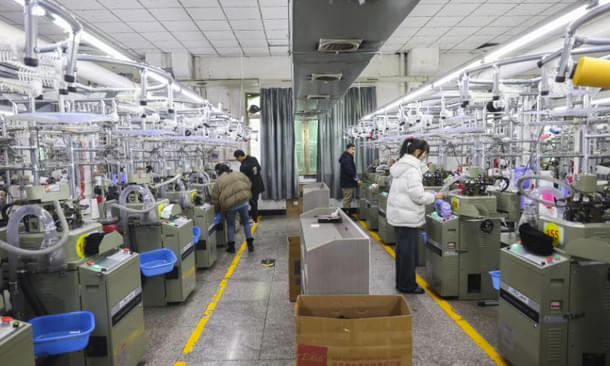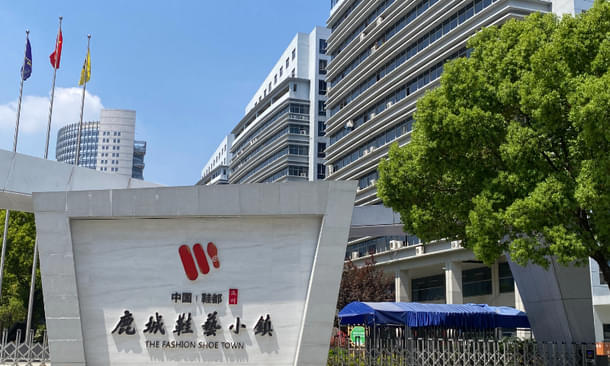Economy
The Sock City Lesson: What Indian States Can Learn From China’s Clusters
Amit Mishra
Jun 12, 2025, 12:49 PM | Updated Jul 01, 2025, 09:20 AM IST
Save & read from anywhere!
Bookmark stories for easy access on any device or the Swarajya app.


"Buyers from New York to Tokyo want to be able to buy 500,000 pairs of socks all at once, or 300,000 neckties, 100,000 children’s jackets, or 50,000 size 36B bras. Increasingly, the places that best accommodate orders are China’s giant new specialty cities. . . . Each was built to specialize in making just one thing, including some of the most pedestrian of goods: cigarette lighters, badges, neckties, and fasteners. The clusters are one reason China’s shipments of socks to the U.S. have soared from 6 million pairs in 2000 to 670 million pairs last year [2004]."
This excerpt from a report by a US-based think tank quantifies how industrial clusters have fuelled China’s rise—arguably the most compelling economic story of the 21st century.
So why hasn’t India—with its vast entrepreneurial base and demographic edge—replicated this success story through its own Micro, Small, and Medium Enterprises (MSMEs)?
That’s the question a recent NITI Aayog report on MSMEs compels us to ask. Are India’s MSME clusters falling short—or are there silent success stories waiting to be amplified?
Small businesses—or technically, MSMEs—have always dominated the industrial landscape of India by sheer numbers and geographic spread. They contribute 29.7 per cent to India’s GDP, account for 49.66 per cent of exports, and drive almost 45 per cent of the country’s manufacturing output.
The Cluster Conundrum
In global industrial policy, a “cluster” refers to a geographical concentration of inter-connected enterprises and associated institutions that face common challenges and opportunities.
India introduced its first formal cluster policy in 1987.
But implementation has been narrow. Most Indian policies have treated clusters as a collective efficiency model where businesses of a similar type co-locate and perhaps share resources.
The 2010-launched Micro and Small Enterprises Cluster Development Programme (MSE-CDP), aimed at creating Common Facilitation Centres (CFCs), has largely faltered. Many of these CFCs remain underfunded, underutilized, and unable to scale or modernise.
Clusters are regional by nature. That means states hold the key. And therein lies another weakness. Most Indian states lack updated, sector-specific blueprints. Tamil Nadu, Gujarat, and Karnataka are partial exceptions. But on the whole, state-level cluster development remains an afterthought, not a core strategy.
Meanwhile, global benchmarks have moved on. In the EU and US, clusters are used for everything from export planning to R&D strategy to vocational training alignment. In India, they’re still treated as geographic zones rather than economic ecosystems.
The result? A country with the world’s second-largest MSME base but with marginal presence in global value chains (GVCs). As of 2017, India accounted for just 1.5 per cent of GVC exports—dwarfed by countries with far smaller industrial bases.
Anatomy of a Bottleneck
Take textiles — one of India’s traditional strengths. Regions like Tiruppur, Surat, and Ludhiana have long been hubs of production. But their positioning within the value chain remains rudimentary.
Most units here focus on upstream activities like weaving and spinning, leaving the higher-margin design, branding, and final-product assembly to players abroad. This skews the economics of the cluster and limits its ability to compete internationally. What these clusters need is not more looms but more labs — for design, for digital merchandising, for smart textiles, and for fashion branding.
In the chemicals sector, the situation is equally striking. Regions like Vapi and Ankleshwar boast a high density of chemical enterprises, yet they grapple with a critical shortfall of skilled personnel, complex regulatory processes, and limited R&D capabilities. This leads to a predominance of low-margin, generic chemical manufacturing, with very few firms able to make the leap into specialty chemicals.
Automotive clusters like those in Pune, Gurgaon, and Rewari present a different set of challenges. While they benefit from proximity to large original equipment manufacturers (OEMs), the MSMEs within these ecosystems remain relegated to contract supply roles. Most operate without proprietary IP or advanced technological capabilities. As a result, their growth is tethered to the fortunes of larger players, leaving them vulnerable to supply chain shocks and offering little room for upward mobility.
The food processing clusters in India’s northeast and eastern regions offer another revealing case. Rich in biodiversity and agricultural output, these areas hold immense untapped potential. Yet, the absence of logistics infrastructure, modern processing units, and branding capabilities reduces them to suppliers of raw or minimally processed goods.
What China Got Right
China’s SME cluster miracle didn’t emerge from thin air — and it certainly wasn’t built on low-cost labour alone. At the core of this transformation lay a deceptively simple but profoundly effective formula: specialise, organise, and localise.
In industrial hubs like Datang and Wenzhou, this strategy came alive. Datang, tucked in Zhejiang province, offers a textbook example of how clustering works at scale.
Known today as the “Sock Capital of the World,” Datang is home to more than 2,400 sock manufacturers. But the magic lies in what surrounds them — 550 raw material firms, 400 material dealers, hundreds of hemstitching, dyeing, and packing units, over 600 sock dealers, and more than 100 shipment service providers. Add to that 1,600 retail outlets in the bustling Sock City market complex, and you have not just a town, but a self-sustaining industrial universe.

A similar model drives the Wenzhou footwear cluster, where over 4,000 firms engage in everything from leather cutting to sales, services, and shoe machinery manufacturing.
Because the production process is technically divisible, each small and medium enterprise (SME) tends to cover an individual phase of production. This kind of division of labour lowers entry barriers dramatically.

The success of Chinese industrial clusters is inseparable from local governments’ strong support and nurturing. This support often comes during the middle or later stages when the clusters have demonstrated their potential. Although the support is multifaceted, it tends to focus primarily on building a good business environment and on the “market failure” or “externality” areas.
So while Chinese government has given high priority to provision of basic infrastructure such as roads, water, electricity, and telephone lines, local governments have tried to build a specialised market or industrial park to facilitate business activities. Such a market brings suppliers, producers, sellers, and buyers together and helps build the forward and backward linkages, thus facilitating the scaling up of the clusters.
But beyond infrastructure, what truly set China’s model apart was its ability to step in when quality faltered. This practice is especially common in the Wenzhou shoe cluster which became infamous for being cheap and shoddy.
Rather than letting the market collapse under its own weight, the municipal government stepped up. It imposed strict quality standards, encouraged firms to brand their products, and repositioned the cluster as a reliable source of well-made footwear. That intervention didn’t just fix a problem — it saved an entire industry.
Elsewhere, cities introduced standards not just for products, but for investments themselves. In Guangdong, cities began evaluating new industrial proposals based on land efficiency and environmental impact, nudging clusters toward sustainable growth.
Recognising that innovation couldn’t be left to chance, provincial and township governments have also invested directly in technology centres. Because imitation within a cluster is easy, firms hesitate to invest in innovation and technology upgrading, and thus government intervention can be justified.
In Guangdong since 2000, the provincial government has invested RMB 3,00,000 in each specialised town, with matching funds from local governments, to build a public technology innovation center (TIC) to support the clusters’ innovation and technology activities.
In the case of Xiqiao, the township government first set up the Fabrics Sample Manufacturing Corporation to develop new fabrics, new dyeing processes, and new printing formulas. After initial success, and with the support of provincial and municipal governments, in 2000 the town of Xiqiao established the Southern Technology Innovation Center to provide technology and innovation services to enterprises at below-market prices.
In China, many clusters have also benefited from state-owned enterprises (SOEs) and FDI, which provided important initial technology and a crucial impetus for the clusters’ development.
The Wenzhou footwear cluster illustrates this beautifully. One SOE — Dongfanghong Leather Footwear Factory — eventually seeded three major companies, which in turn spun off dozens more. Firms like Aokang and Hongqingting became household names, not just in Wenzhou, but across China.
Clusters also benefited from foreign direct investment, particularly from the Chinese diaspora in Hong Kong, Taiwan, and Macao. Their capital, expertise, and global market access supercharged regions like Dongguan and Huizhou.
The Kunshan IT cluster in Jiangsu, for example, became a powerhouse thanks to Taiwanese investment, which accounted for nearly 25 per cent of total investment in the region. Global giants like Acer, IBM, and Lenovo set up shop, bringing with them advanced machinery and know-how, and offering local SMEs a direct link to the global value chain.
That said, the Chinese policy is not flawless.
While specialisation fosters deep expertise, it risks stifling cross-sector collaboration – particularly in an interconnected world in which breakthroughs often occur where fields intersect, writes Jeffrey Wu of MindWorks Capital, a Hong Kong-based VC firm.
China also faces distinct challenges in balancing specialisation and competition. Clustering too many companies within the same technological niches risks cannibalising essential resources, argues Wu.
Reimagining India’s Cluster Identity
India doesn’t lack MSME schemes. It suffers from policy fragmentation. From SFURTI to ECLGS to MSE-CDP, the alphabet soup confuses more than it coordinates. More funds won’t fix the problem—strategy will.
There are global models India could adapt.
In Germany, the famed Mittelstand companies thrive in tight-knit industrial clusters supported by vocational training institutes and innovation-focused policy.
In Italy’s Emilia-Romagna, small textile and design firms collaborate deeply through regional value chains supported by public institutions. Malaysia and Thailand have successfully deployed sensor-based cold chains for their agri-processing clusters, linking small farmers to international markets.
India has the diversity, scale, and demographic dividend to emulate — or exceed — these models. But it must embrace these ideas, else MSME miracle will remain a story half-told.





